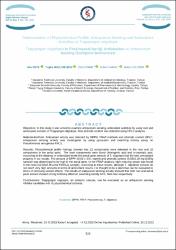| dc.contributor.author | Reis, Ahu | |
| dc.contributor.author | Mazlum Şen, Tuğba | |
| dc.contributor.author | Önem, Ebru | |
| dc.contributor.author | Saral, Özlem | |
| dc.contributor.author | Gültepe, Mutlu | |
| dc.date.accessioned | 2023-03-06T10:49:13Z | |
| dc.date.available | 2023-03-06T10:49:13Z | |
| dc.date.issued | 2022 | en_US |
| dc.identifier.citation | Reis, A., Mazlum Şen, T., Önem, E., Saral, Ö. & Gültepe, M. (2022). Determination of Phytochemical Profile, Antiquorum Sensing and Antioxidant Activities of Tragopogon oligolepis. Süleyman Demirel Üniversitesi Sağlık Bilimleri Dergisi, 13(3), 522-530. https://doi.org/10.22312/sdusbed.1193199 | en_US |
| dc.identifier.issn | 2146-247X | |
| dc.identifier.uri | https://doi.org/10.22312/sdusbed.1193199 | |
| dc.identifier.uri | https://hdl.handle.net/11436/7789 | |
| dc.description.abstract | Objective: In this study it was aimed to examine antiquorum sensing, antioxidant activities by using root and
aerial parts extracts of Tragopogon oligolepis. Also phenolic content was detected using HPLC analysis.
Material-Method: Antioxidant activity was detected by DPPH, FRAP methods and phenolic content HPLC.
Antiquorum sensing activity was investigated by using pyocyanin and swarming motility assay on
Pseudomonas aeruginosa PAO1.
Results: Phytochemical profile findings showed that 12 components were detected in the root and 10
components in the aerial parts. The main components were found chlorogenic acid and o-coumaric acid.
According to the obtained of antioxidant levels the aerial parts extracts of T. oligolepis had the best antioxidant
property in our results. The amount of DPPH (0.60 ± 0.01 mg/ml) and phenolic content (6.55±0.18 mg GAE/g
sample) was determined to be high in the aerial parts. In the FRAP analysis, high reducing power was found
in the roots (12.62±0.36 μmol FeSO4/g sample). According to these results, although T. oligolepis extracts do
not reach very high amounts in terms of antioxidant results, it is thought to be a plant that can be evaluated in
terms of removing oxidant effects. The results of antiquorum sensing activity showed that both root and aerial
parts extract showed strong inhibitory effect on swarming motility 62%, %65 rate respectively.
Conclusions: Tragopogon oligolepis, an endemic species, can be evaluated as an antiquorum sensing
inhibitor candidate with its phytochemical contents. | en_US |
| dc.description.abstract | Amaç: Bu çalışmada, Tragopogon oligolepis'in kök ve toprak üstü kısım ekstraktları kullanılarak antiquorum
sensing ve antioksidan aktivitelerinin incelenmesi amaçlanmıştır. Ayrıca HPLC analizi kullanılarak fenolik
içerik tespit edilmiştir.
Gereç Yöntem: Antioksidan aktivite DPPH, FRAP yöntemleri ve fenolik içerik HPLC ile tespit edildi. Çevreyi
algılama aktivitesi, Pseudomonas aeruginosa PAO1 üzerinde piyosiyanin ve kayma hareketi testi kullanılarak
araştırıldı.
Bulgular: Fitokimyasal profil bulguları, kökte 12 bileşen ve toprak üstü kısımlarda 10 bileşen tespit edildiğini
göstermiştir. Ana bileşenler klorojenik asit ve o-kumarik asit olarak bulunmuştur. Elde edilen antioksidan
seviyelerine göre, sonuçlarımızda en iyi antioksidan özelliği T. oligolepis'in toprak üstü kısımları ekstreleri
göstermiştir. Toprak üstü kısımlarda DPPH (0.60 ± 0.01 mg/mL) ve fenolik içerik (6.55±0.18 mg GAE/g
numune) miktarının yüksek olduğu belirlendi. FRAP analizinde köklerde yüksek indirgeme tespit edildi
(12.62±0.36 μmol FeSO4/g numune). Antiquorum sensing sonuçlarına göre ise kök ve toprak üstü ektraktları
kayma hareketi üzerine %62 ve %65 oranında güçlü inhibisyon etki göstermiştir.
Sonuç: Elde edilen sonuçlar neticesinde endemik bir tür olan T. oligolepis, fitokimyasal içeriği ile antiquorum
sensing inhibitör adayı olarak değerlendirilebilir. | en_US |
| dc.language.iso | eng | en_US |
| dc.publisher | Süleyman Demirel University | en_US |
| dc.rights | info:eu-repo/semantics/openAccess | en_US |
| dc.subject | DPPH | en_US |
| dc.subject | FRAP | en_US |
| dc.subject | Pseudomonas | en_US |
| dc.subject | T. oligolepis | en_US |
| dc.title | Determination of phytochemical profile, antiquorum sensing and antioxidant activities of tragopogon oligolepis | en_US |
| dc.title.alternative | Tragopogon oligolepis’ın fitokimyasal içeriği, antioksidan ve antiquorum sensing özelliğinin belirlenmesi | en_US |
| dc.type | article | en_US |
| dc.contributor.department | RTEÜ, Sağlık Yüksekokulu, Beslenme ve Diyetetik Bölümü | en_US |
| dc.contributor.institutionauthor | Saral, Özlem | |
| dc.identifier.doi | 10.22312/sdusbed.1193199 | en_US |
| dc.identifier.volume | 13 | en_US |
| dc.identifier.issue | 3 | en_US |
| dc.identifier.startpage | 522 | en_US |
| dc.identifier.endpage | 530 | en_US |
| dc.relation.journal | Suleyman Demirel University The Journal of Health Science | en_US |
| dc.relation.publicationcategory | Makale - Uluslararası Hakemli Dergi - Kurum Öğretim Elemanı | en_US |


















